28 Aug 2024 - {{hitsCtrl.values.hits}}
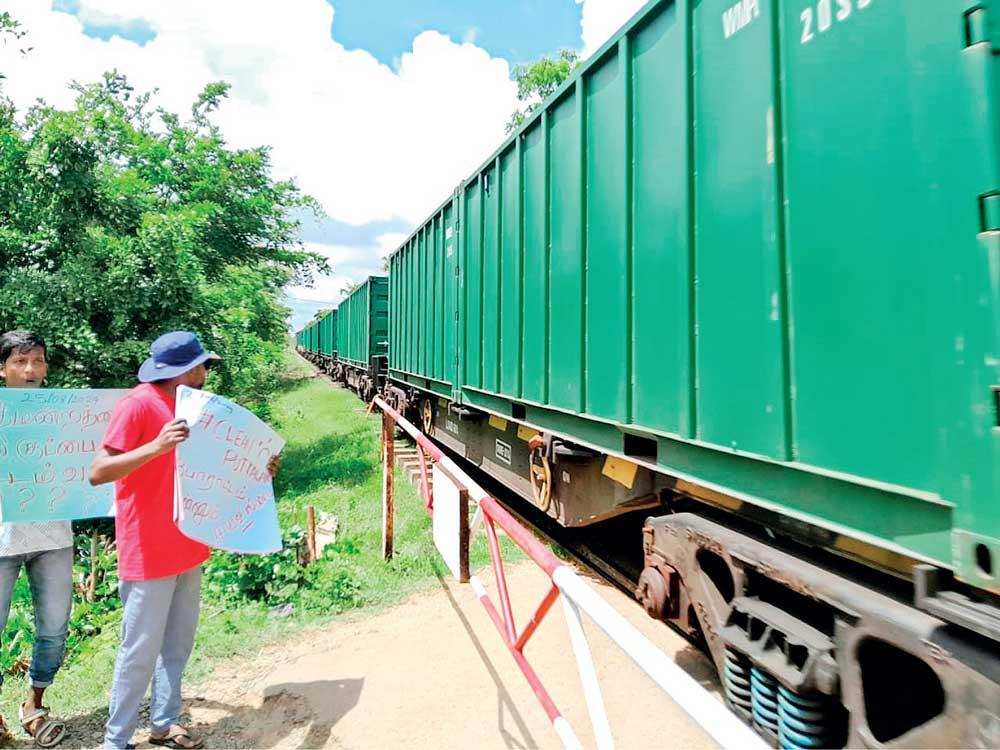
Garbage containers being transported via train
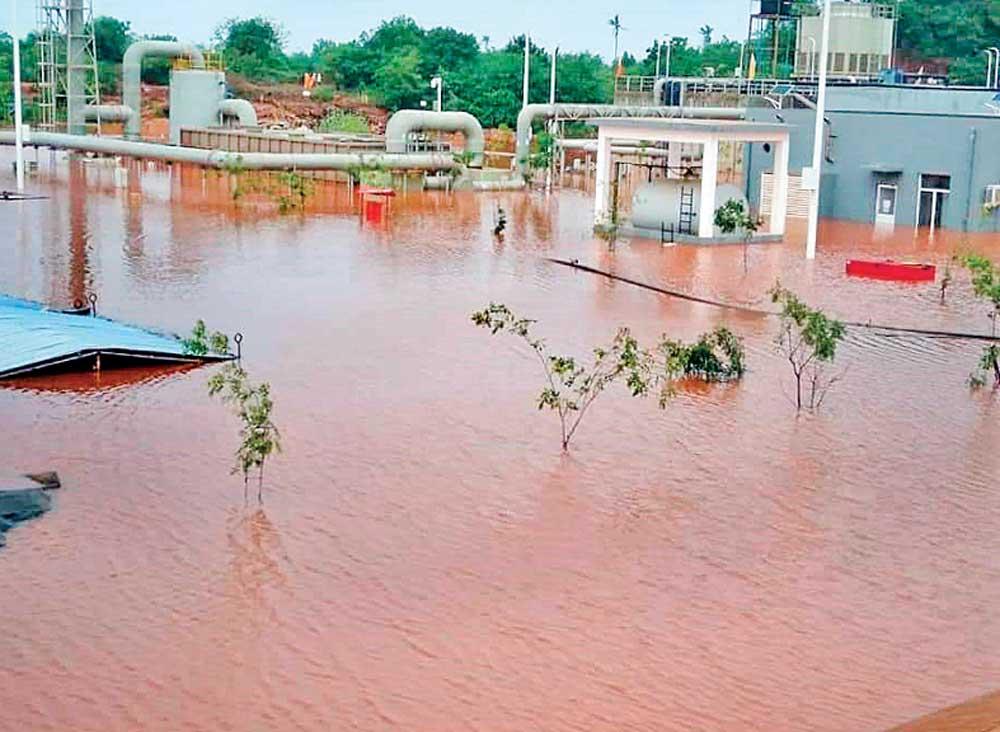 Aruwakkalu inundated during heavy rains in 2019.
Aruwakkalu inundated during heavy rains in 2019.
Image courtesy - Clean Puttalam campaign
On Saturday (August 24), during the wee hours of the morning, a group of residents from Puttalam staged a protest at the Noor Nagar Railway station against the transportation of waste via train to the Aruwakkalu Sanitary Landfill site. A total of 20 containers of solid waste were dumped at the Aruwakkalu site as a trial under the Metro Colombo Metropolitan Solid Waste Management Plan.
Controversies galore
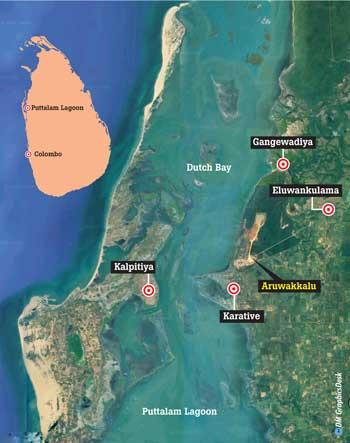 Following the collapse of the Meethotamulla garbage dump in 2017, the then Government intensified efforts to bring about a long-term solution to the waste management crisis, especially in the Western Province. The Aruwakkalu Sanitary Landfill Project was first proposed in 2014 at a cost of US$ 107 million. The project was to be funded by the World Bank, but the contract was later offered to China Harbour Engineering Corporation (CHEC) – an entity blacklisted by the World Bank and had no prior experience in constructing a landfill site. However, environmentalists and residents in surrounding villages protested against the proposed location in Puttalam. Construction work began in 2018 and the project was expected to conclude by March 2020. The Aruwakkalu project came under scrutiny for not following proper environmental guidelines and given that there was a failure of disbursing payments, the project contractor abandoned the project in June 2022. Even though the project was initially proposed by Megapolis and Western Development Ministry it later came under the purview of the Ministry of Urban Development and Housing.
Following the collapse of the Meethotamulla garbage dump in 2017, the then Government intensified efforts to bring about a long-term solution to the waste management crisis, especially in the Western Province. The Aruwakkalu Sanitary Landfill Project was first proposed in 2014 at a cost of US$ 107 million. The project was to be funded by the World Bank, but the contract was later offered to China Harbour Engineering Corporation (CHEC) – an entity blacklisted by the World Bank and had no prior experience in constructing a landfill site. However, environmentalists and residents in surrounding villages protested against the proposed location in Puttalam. Construction work began in 2018 and the project was expected to conclude by March 2020. The Aruwakkalu project came under scrutiny for not following proper environmental guidelines and given that there was a failure of disbursing payments, the project contractor abandoned the project in June 2022. Even though the project was initially proposed by Megapolis and Western Development Ministry it later came under the purview of the Ministry of Urban Development and Housing.
Validity of EPL
Prior to dumping garbage at a specified location, a valid Environmental Protection Licence (EPL) is required as per Section 23A of the National Environmental Act. As per the regulations introduced to the North Western Provincial Environmental Statute No. 12 of 1990 (cited as the Provincial Environmental (Protection and Quality) Regulation No. 1 of 2010) no person shall discharge, deposit or emit waste into the environment or carry out any prescribed activity that is likely to cause pollution unless they have obtained a licence from the Provincial Environmental Authority. It is in this backdrop that the Daily Mirror learned that the initial EPL (EPL No. 16912 (RI) issued to carry out waste dumping activities at the Aruwakkalu site had been expired as at 2020/02/25. But when inquired Metro Colombo Metropolitan Solid Waste Management Director R. M. G. S Bandara said that the licence expires on December 15, 2024 (see document attached). However the EPL document indicates that it had been issued for the operation of the Leachate Treatment Plant of the sanitary landfill at Aruwakkalu.
Responding to a query on the issuance of the EPL, S. K Lenaduwa, Director, North Western Provincial Environmental Authority said that both the CEA and NWPEA had issued the EPL for this project. “An EPL needs to be obtained prior to the construction of any project and it is being issued after ensuring that all criteria had been adhered to. A test trial is being done to transport solid waste from Colombo to Aruwakkalu via train. But the leachate treatment plant is not yet complete and we have been informed that this plant will be completed by the end of this month. At the moment the leachate is being stored in tanks. There are conditions for odour control and various other aspects,” said Lenaduwa.
He further said that there is no authority to dump any kind of hazardous waste at this site and that it is only being used as a sanitary landfill site.
Need for regulation
Speaking to the Daily Mirror, Senior Environmental lawyer Dr. Jagath Gunawardene said that nobody is allowed to dump garbage at this site without a valid EPL. “It is important to strengthen laws concerning waste dumping and importation of waste into the country. There needs to be some kind of regulation under the National Environment Act or any other related act. The Ministry should look into it without getting the Central Environmental Authority (CEA) to manage the dumping of waste,” said Gunawardene.
He added that there needs to be a national waste management authority to look into the day-to-day management of waste in the Western Province for example. He suggested that everything from the importance of waste to dumping of raw materials to dumping of domestic, clinical waste and taking care of by products needs to be regulated.
A substandard project?
According to Aruwakkalu Project Director Bandara, the main objective of this project is to receive 1200 tonnes of garbage daily. “During the trial we were able to transport around 17.8 tonnes of garbage, but the standard amount is 20 tonnes. It costs around Rs. 1.3 million to transport garbage per trip,” he added. But environmentalists speculate whether there would be adequate garbage to fill the Aruwakkalu site. “Garbage is being dumped at the Karadiyana garbage dump as well. In my opinion there won’t be enough waste left to fill the Aruwakkalu sanitary landfill site,” said Jayantha Wijesinghe, Co-founder, Rainforest Protectors Sri Lanka.
The location proposed for this landfill site had been of particular concern as it is located in close proximity to the Puttalam Lagoon on one end and several other villages in its vicinity. “There had been major environmental concerns with regards to this landfill site. The sanitary landfill concept came about in 1940s and ‘50s and it needs to be constructed in a basin while taking the geography, soil, wind conditions and various other factors into consideration. But the Aruwakkalu site experiences crosswinds and the constructions were substandard and there were explosions from time to time. This area has a shallow groundwater table and there’s a risk of leachate leaking into the lagoon and waterways,” he explained.
Wijesinghe further said that rather than setting up a substandard landfill site the investment should have been allocated to setup gasification units in various locations to address the waste management crisis in the country. “Waste segregation is an important area that could provide job opportunities to people. But there has been no consideration regarding such concepts. In fact this site could be used for some other purpose. There had been no value additions such as making use of biofuel or byproducts from processing waste. Perhaps this site could be used to dump garbage in surrounding areas or for a similar multipurpose project that would have little to no impact on the environment,” he added.
Residents continue with their fight
Since the inception of this project residents in surrounding villages including Serakkuliya, Gangewadiya and Eluwankulama staged protests. They claim that they were not informed about what sort of project it would be. “We only knew about this project when they started constructions,” said U. D Fernando, a resident from Serakkuliya. “Perhaps they didn’t want people to know about this project. The site is located around 170 metres from our village. At that time it looked like they were going to shift the Meethotamulla garbage issue to this area. The location is not suitable for this project at all. According to the EIA a landfill should not be located in proximity to any human settlements, water bodies etc. This site is an abandoned limestone quarry that was used for cement production. But it looks like they had no clue about the soil composition on this land. On the other hand it is located at an elevation and is around 170 metres away from the lagoon,” added Fernando.
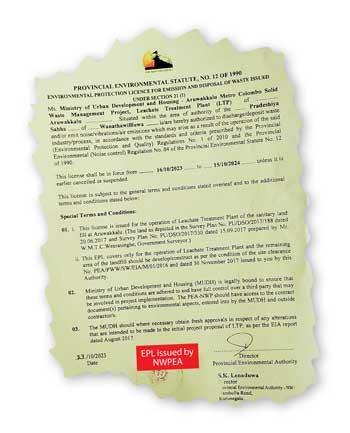 He recalled how garbage was dumped in an earlier instance and how residents were unable to bear the stench. “There is a school in close proximity and some students experienced nausea and vomiting and people had to remain behind closed doors. Imagine the plight of people if garbage dumping continues. As a result we lodged complaints with the police and took to the streets, but they forcibly dumped garbage. The only facility we have is the chance to breathe freely and what can we do if we are deprived of that too,” Fernando questioned.
He recalled how garbage was dumped in an earlier instance and how residents were unable to bear the stench. “There is a school in close proximity and some students experienced nausea and vomiting and people had to remain behind closed doors. Imagine the plight of people if garbage dumping continues. As a result we lodged complaints with the police and took to the streets, but they forcibly dumped garbage. The only facility we have is the chance to breathe freely and what can we do if we are deprived of that too,” Fernando questioned.
The Daily Mirror learned that the site gets flooded during heavy rains. According to Fernando the tanks that are supposed to store leachate get inundated due to floods. “This shows that the officials don’t have any idea about the rains either. This area is subject to both Southwest and Northeast monsoons. Going forward, any government should look at reducing the impact on communities as a result of such projects,” he said.
The ‘Clean Puttalam’ campaign was launched in an attempt to voice dissent against the project, uniting residents, civil society groups, NGOs, youth groups, women’s associations, religious leaders and political groups. In August 2019 residents filed a Writ Petition (WRT-0310-19) at the Court of Appeal against this project which was taken for argument in August 2024. The next hearing is scheduled for December 16, 2024.
The project was inundated due to floods and in that case what would happen to the machinery? The Gotabaya Rajapaksa regime didn’t allow any project to be executed. The Meethotamulla garbage dump was transformed into an urban park, but he didn’t even provide a single drop of water
Responding to claims regarding the quality of the waste dump project, Former Minister for Megapolis and Western Development Patali Champika Ranawaka said that the project was abandoned for five years and only a part of the project was commissioned. “The project was inundated due to floods and in that case what would happen to the machinery? The Gotabaya Rajapaksa regime didn’t allow any project to be executed. The Meethotamulla garbage dump was transformed into an urban park, but he didn’t even provide a single drop of water. There was no plan to execute the Light Rail Transit project or the Kelani Valley Railway project or the Multimodal Transport Terminal Development Projects in Kandy, Battaramulla, Pettah,” said Ranawaka.
He further said that people have been facing the waste management crisis for 40 long years. “The Aruwakkalu project was proposed to address the garbage crisis in Western Province, but it was criticised from the beginning. When the Port City was being built there were claims that Colombo would sink as a result of this new project,” he exclaimed.
Ranawaka added that he is pleased to hear that this project has now commenced. “What needs to be done as an initial step is to obtain bottom ash from the Kerawalapitiya waste-to-energy plant and fill the land,” he suggested further. “However there have been various attempts to instil fear in the people and make them protest,” he said.
When asked about the location of the project, Ranawaka claimed that it was selected by a group of esteemed environmentalists. Responding to a query on the import of foreign waste, he said that Sri Lanka Customs and Quarantine Departments should enforce the law to apprehend culprits involved in such fraudulent activities.
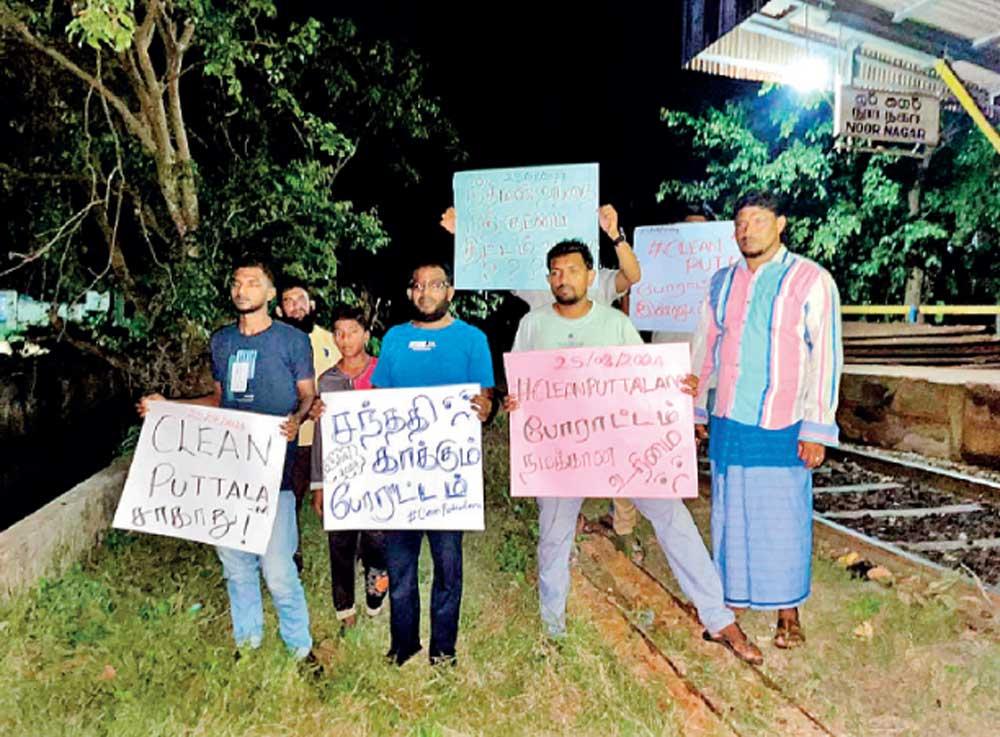
Protest staged by area residents
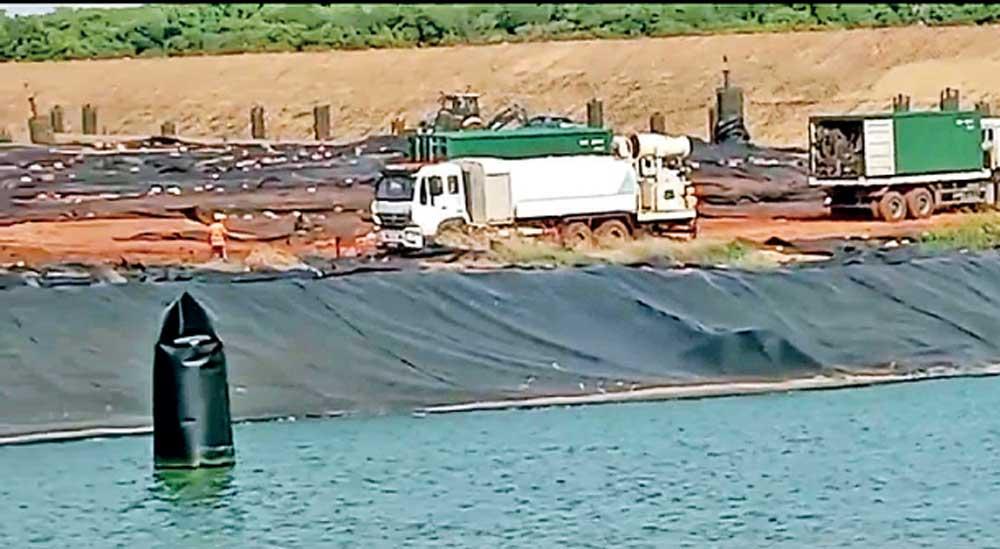
Garbage being dumped during recent
the operational trial
An EPL needs to be obtained prior to the construction of any project and it is being issued after ensuring that all criteria had been adhered to. A test trial is being done to transport solid waste from Colombo to Aruwakkalu via train. But the leachate treatment plant is not yet complete and we have been informed that this plant will be completed by the end of this month
- S. K. Lenaduwa, Director, North Western Provincial Environmental Authority
It is important to strengthen laws concerning waste dumping and importation of waste into the country. There needs to be some kind of regulation under the National Environment Act or any other related act. The Ministry should look into it without getting the Central Environmental Authority (CEA) to manage the dumping of waste
- Dr. Jagath Gunawardene Senior Environmental lawyer
There had been major environmental concerns with regards to this landfill site. The sanitary landfill concept came about in 1940s and ‘50s and it needs to be constructed in a basin while taking the geography, soil, wind conditions and various other factors into consideration. But the Aruwakkalu site experiences crosswinds and the constructions were substandard and there were explosions from time to time
- Jayantha Wijesinghe, Co-founder Rainforest Protectors Sri Lanka
We only knew about this project when they started constructions. Perhaps they didn’t want people to know about this project. The site is located around 170 metres from our village. At that time it looked like they were going to shift the Meethotamulla garbage issue to this area. The location is not suitable for this project at all
- U.D. Fernando,
a resident from Serakkuliya
24 Dec 2024 7 minute ago
24 Dec 2024 29 minute ago
24 Dec 2024 2 hours ago
24 Dec 2024 3 hours ago
24 Dec 2024 3 hours ago